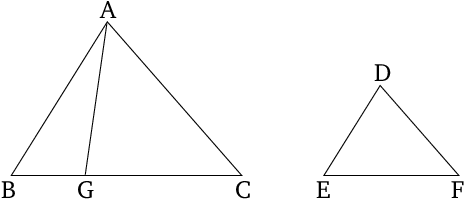Similar triangles are to one another in the squared1 ratio of (their) corresponding sides.

With $a:=|\overline{AB}|,$ $b:=|\overline{BC}|,$ $\gamma=\angle{ABC},$ $a':=|\overline{DE}|,$ $b':=|\overline{EF}|,$ and $\gamma'=\angle{DEF},$ this proposition states that if in two triangles $\triangle{ABC}$ $\triangle{DEF},$ the angles are equal $\gamma=\gamma'$ and the corresponding sides being the legs of these angles are proportional $\frac ab=\frac {a'}{b'}$ then $$\frac{\operatorname{area}\triangle{ABC}}{\operatorname{area}\triangle{DEF}}=\frac {b^2}{b'^2}.$$
$$\begin{array}{rcll} \frac {a}{b}&=&\frac {a'}{b'}&|\cdot \frac {b^2}{a'b'}\\ \frac {ab}{a'b'}&=&\frac {b^2}{b'^2}\\ \frac {\frac 12ab\sin(\gamma)}{\frac 12a'b'\sin(\gamma')}&=&\frac {b^2}{b'^2}&(\text{since }\gamma=\gamma')\\ \frac{\operatorname{area}\triangle{ABC}}{\operatorname{area}\triangle{DEF}}&=&\frac {b^2}{b'^2} \end{array}$$
Literally, "double" (translator's note). ↩